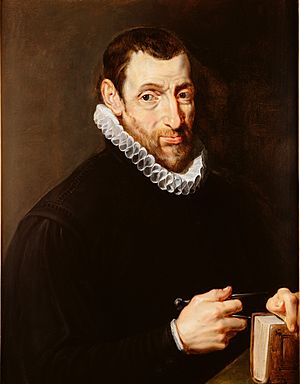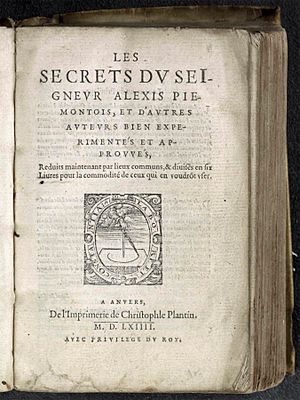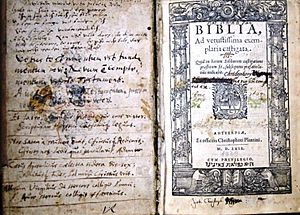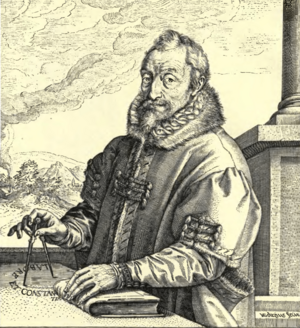Christophe Plantin facts for kids
Quick facts for kids
Christophe Plantin
|
|
|---|---|

Posthumous portrait of Plantin by Rubens
|
|
| Born | c. 1520 |
| Died | 1 July 1589 |
| Resting place | Antwerp |
| Years active | 1548–1589 |
| Known for | Plantin Press |
Christophe Plantin (born around 1520 – died July 1, 1589) was a famous French Renaissance humanist and a very important printer and publisher. He lived and worked in the city of Antwerp, which is now in Belgium. Plantin became one of the most successful printers of his time, known for producing beautiful and accurate books.
Life of a Master Printer
Christophe Plantin was born in France, probably near the city of Tours. His family was not rich, and his mother passed away when he was young. As a teenager, he learned the skill of bookbinding in Caen, France. Bookbinding is the art of putting pages together to make a book.
In 1545, Plantin and his wife, Joanna Rivière, opened a shop in Paris. But after three years, they decided to move to Antwerp. Antwerp was a busy and growing city for business back then. In Antwerp, Plantin became a free citizen and joined the Guild of St Luke. This guild was a group for artists and craftsmen, including printers.
The excellent quality of his bookbinding work helped him meet important and wealthy people. By 1549, he was running one of the most respected publishing houses in Europe. He printed all sorts of books, from famous Roman writings by Cicero to religious hymnals (songbooks).
One day, while delivering a special order, he was accidentally attacked and hurt his arm. This injury meant he could no longer work as a bookbinder. So, he decided to focus completely on typography (designing typefaces) and printing. By 1555, he had his own printing shop and was a skilled printer. His first known printed book was La Institutione di una fanciulla nata nobilmente, which was a French translation of an Italian work. Soon, he printed many other books in French and Latin. These books were so well made that they were as good as the best printing of that time.
The art of engraving was very popular in the Netherlands (where Antwerp is). Many Dutch engravers created pictures for Plantin's books. However, Antwerp could be a dangerous place for publishers. In 1561, the Spanish governor ordered a search of Plantin's workshop. They thought he might be hiding books that went against the official religion or that he supported Protestants. To avoid being arrested, Plantin quickly sold all his books. As soon as things calmed down, he bought them all back.
In 1562, while Plantin was away in Paris, his workers printed a pamphlet that was considered to be against the official religion. Because of this, his printing presses and goods were taken away and sold. But he managed to get back most of what he lost. With help from four merchants in Antwerp, he was able to restart and greatly expand his printing business. These friends even gave him beautiful Hebrew typefaces (fonts) from a famous printer in Venice.
This partnership lasted until 1567. It helped Plantin buy a house in the Hoogstraat which he named "De Gulden Passer" (The Golden Compasses). This name was a nod to the success of publishing emblem books, which were books with pictures and short, often mysterious, text explanations. Around this time, Plantin also chose a special symbol for his printing house. This symbol, called a printer's mark, would appear on the title pages of all Plantin Press books.
The motto Labore et Constantia ("By Labor and Constancy") surrounded the symbol of a pair of compasses. A hand reaching from clouds held the compasses and drew a circle. The fixed point of the compasses showed "constancy" (staying steady), and the moving point that drew the circle showed "labor" (hard work). Plantin himself is shown holding this instrument in his portraits, like the one painted by the famous Flemish artist Peter Paul Rubens.
In November 1576, Spanish soldiers attacked and burned Antwerp. This event greatly reduced Antwerp's power as a major business city in Europe. Plantin had to pay a huge amount of money to protect his printing works. He then opened a branch of his company in Paris. In 1583, the region of Holland needed a printer for their new university in Leiden. Plantin moved there, leaving his smaller business in Antwerp to his sons-in-law, John Moerentorf and Frans van Ravelingen (Raphelengius).
Plantin later left his Leiden office to Raphelengius. He returned to Antwerp after the city became more stable following its capture by the prince of Parma in 1585. Plantin continued to work in Antwerp until he passed away.
Amazing Printing Work
Plantin was a very active printer and a successful businessman. He published over 40 different editions of emblem books. His most important work is considered to be the Biblia Regia (King's Bible), also known as the Plantin Polyglot.
The Netherlands was a difficult place for printers at this time, with many conflicts. Plantin needed a powerful supporter who wouldn't be accused of going against the official religion or supporting Protestants. Despite some religious opposition, King Philip II of Spain encouraged Plantin. The King sent a learned scholar named Benito Arias Montano to lead the editing of the Bible.
The Polyglot Bible was special because it had parallel texts in many languages: Latin, Greek, Syriac, Aramaic, and Hebrew. This project was very expensive for Plantin. He even had to mortgage (borrow money against) his own business to pay for it. He hoped it would be worth it in the end. It took thirteen printing presses and fifty-three men to finish the job! Special characters for each language were needed. A French type designer named Claude Garamond created the steel punches (tools for making type). With Montano's strong help, the huge work was completed in four years (1568-1572). It was printed in eight large volumes, meaning only two pages could be printed at a time.
This project didn't make Plantin a lot of money. However, King Philip II gave him a special permission: Plantin could print all Roman Catholic liturgical books (like missals and breviaries) for the lands ruled by Philip. He also received the title "Architypographus Regii" (Royal Chief Printer), which he proudly added to his books. He also had the duty of prototypo-graphus regius, which meant he had to check and approve other printers' skills and make sure their books followed the official religious teachings.
Besides the Plantin Polyglot, Plantin published many other important works. These included the "Dictionarium Tetraglotton" from 1562, which was a dictionary in Greek, Latin, French, and Flemish. He also printed works by famous thinkers like St. Augustine and St. Jerome, and botanical (plant) books by scientists like Dodonaeus, Clusius, and Lobelius. He also published a description of the Netherlands by Guicciardini. His editions of the Bible in Hebrew, Latin, and Dutch, his law books (Corpus juris), Latin and Greek classics, and many other works are famous for being beautifully made and very accurate.
Plantin was a smart businessman. By 1575, his printing company had more than 20 presses and 73 workers. Many other specialists also did work for him from their homes. The huge collection of handwritten ledgers (records) and letters from his company, known as the Officina Plantiniana, can now be seen online.
Although he appeared to be a loyal member of the Catholic Church, it is known that he used his resources to support some groups that were not officially recognized. Many of their books, published without the printer's name, came from Plantin Press.
Plantin's Legacy
After Plantin's death, his company was taken over by his son-in-law, Jan Moretus. Moretus ran the shop in Antwerp, while Francis van Ravelinghen took over the shop in Leiden. Towards the end of the 17th century, the business started to slow down.
However, Plantin's works and his printing house were carefully kept. Today, the building where his company was located is a famous place called the Plantin-Moretus Museum. The Moretus family continued to print many important books. They also kept everything in the office exactly as it was. In 1876, the city of Antwerp bought the old buildings with all their contents. The authorities then easily created the Plantin Museum, which opened on August 19, 1877.
In 1968, the Christophe Plantin Prize was created to honor him. This award is given to a Belgian civilian living abroad who has made important contributions to cultural, artistic, or scientific activities.
See also
 In Spanish: Cristóbal Plantino para niños
In Spanish: Cristóbal Plantino para niños
- Dirk Martens
- Plantin (typeface)
- Lodewijk Elzevir




